2015 NISSAN ROGUE SELECT child restraint
[x] Cancel search: child restraintPage 63 of 322
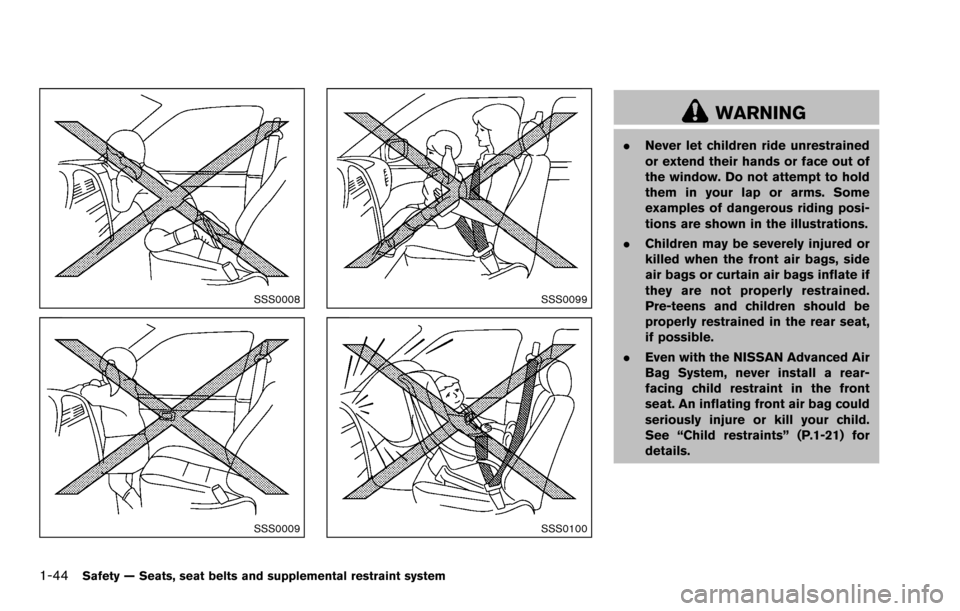
1-44Safety — Seats, seat belts and supplemental restraint system
SSS0008
SSS0009
SSS0099
SSS0100
WARNING
.Never let children ride unrestrained
or extend their hands or face out of
the window. Do not attempt to hold
them in your lap or arms. Some
examples of dangerous riding posi-
tions are shown in the illustrations.
. Children may be severely injured or
killed when the front air bags, side
air bags or curtain air bags inflate if
they are not properly restrained.
Pre-teens and children should be
properly restrained in the rear seat,
if possible.
. Even with the NISSAN Advanced Air
Bag System, never install a rear-
facing child restraint in the front
seat. An inflating front air bag could
seriously injure or kill your child.
See “Child restraints” (P.1-21) for
details.
Page 65 of 322
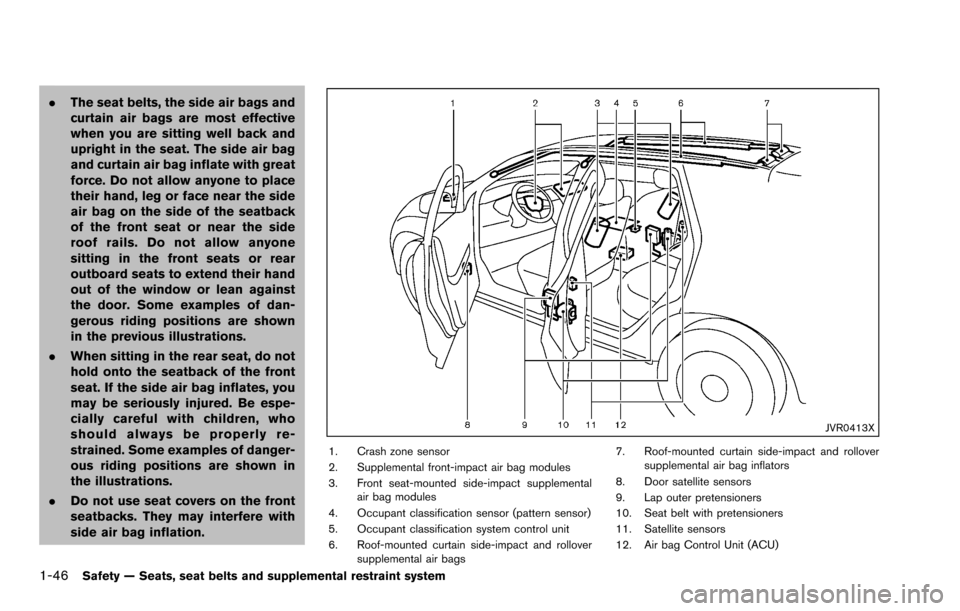
1-46Safety — Seats, seat belts and supplemental restraint system
.The seat belts, the side air bags and
curtain air bags are most effective
when you are sitting well back and
upright in the seat. The side air bag
and curtain air bag inflate with great
force. Do not allow anyone to place
their hand, leg or face near the side
air bag on the side of the seatback
of the front seat or near the side
roof rails. Do not allow anyone
sitting in the front seats or rear
outboard seats to extend their hand
out of the window or lean against
the door. Some examples of dan-
gerous riding positions are shown
in the previous illustrations.
. When sitting in the rear seat, do not
hold onto the seatback of the front
seat. If the side air bag inflates, you
may be seriously injured. Be espe-
cially careful with children, who
should always be properly re-
strained. Some examples of danger-
ous riding positions are shown in
the illustrations.
. Do not use seat covers on the front
seatbacks. They may interfere with
side air bag inflation.
JVR0413X
1. Crash zone sensor
2. Supplemental front-impact air bag modules
3. Front seat-mounted side-impact supplemental
air bag modules
4. Occupant classification sensor (pattern sensor)
5. Occupant classification system control unit
6. Roof-mounted curtain side-impact and rollover supplemental air bags 7. Roof-mounted curtain side-impact and rollover
supplemental air bag inflators
8. Door satellite sensors
9. Lap outer pretensioners
10. Seat belt with pretensioners
11. Satellite sensors
12. Air bag Control Unit (ACU)
Page 67 of 322
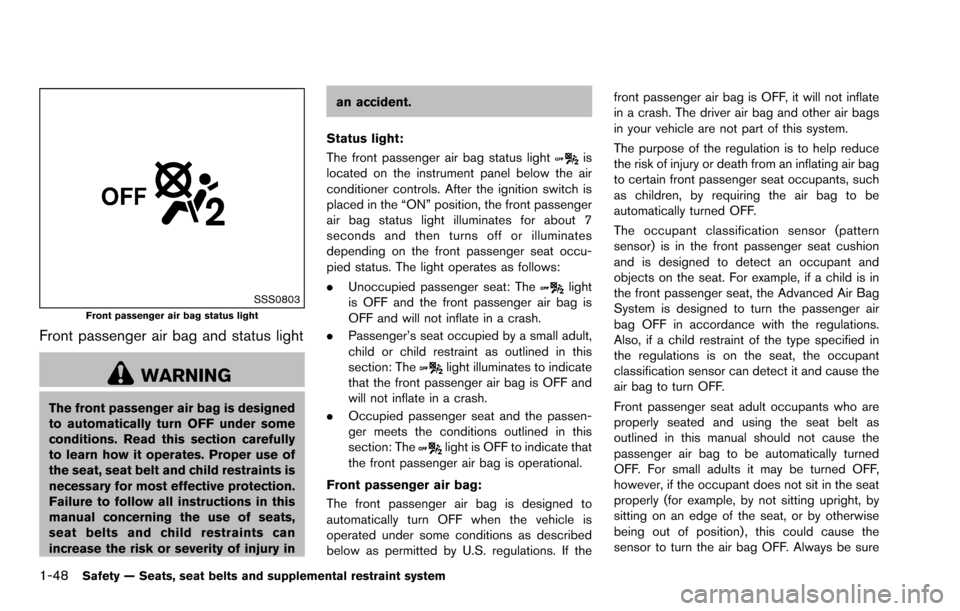
1-48Safety — Seats, seat belts and supplemental restraint system
SSS0803Front passenger air bag status light
Front passenger air bag and status light
WARNING
The front passenger air bag is designed
to automatically turn OFF under some
conditions. Read this section carefully
to learn how it operates. Proper use of
the seat, seat belt and child restraints is
necessary for most effective protection.
Failure to follow all instructions in this
manual concerning the use of seats,
seat belts and child restraints can
increase the risk or severity of injury inan accident.
Status light:
The front passenger air bag status light
is
located on the instrument panel below the air
conditioner controls. After the ignition switch is
placed in the “ON” position, the front passenger
air bag status light illuminates for about 7
seconds and then turns off or illuminates
depending on the front passenger seat occu-
pied status. The light operates as follows:
. Unoccupied passenger seat: The
light
is OFF and the front passenger air bag is
OFF and will not inflate in a crash.
. Passenger’s seat occupied by a small adult,
child or child restraint as outlined in this
section: The
light illuminates to indicate
that the front passenger air bag is OFF and
will not inflate in a crash.
. Occupied passenger seat and the passen-
ger meets the conditions outlined in this
section: The
light is OFF to indicate that
the front passenger air bag is operational.
Front passenger air bag:
The front passenger air bag is designed to
automatically turn OFF when the vehicle is
operated under some conditions as described
below as permitted by U.S. regulations. If the front passenger air bag is OFF, it will not inflate
in a crash. The driver air bag and other air bags
in your vehicle are not part of this system.
The purpose of the regulation is to help reduce
the risk of injury or death from an inflating air bag
to certain front passenger seat occupants, such
as children, by requiring the air bag to be
automatically turned OFF.
The occupant classification sensor (pattern
sensor) is in the front passenger seat cushion
and is designed to detect an occupant and
objects on the seat. For example, if a child is in
the front passenger seat, the Advanced Air Bag
System is designed to turn the passenger air
bag OFF in accordance with the regulations.
Also, if a child restraint of the type specified in
the regulations is on the seat, the occupant
classification sensor can detect it and cause the
air bag to turn OFF.
Front passenger seat adult occupants who are
properly seated and using the seat belt as
outlined in this manual should not cause the
passenger air bag to be automatically turned
OFF. For small adults it may be turned OFF,
however, if the occupant does not sit in the seat
properly (for example, by not sitting upright, by
sitting on an edge of the seat, or by otherwise
being out of position) , this could cause the
sensor to turn the air bag OFF. Always be sure
Page 68 of 322
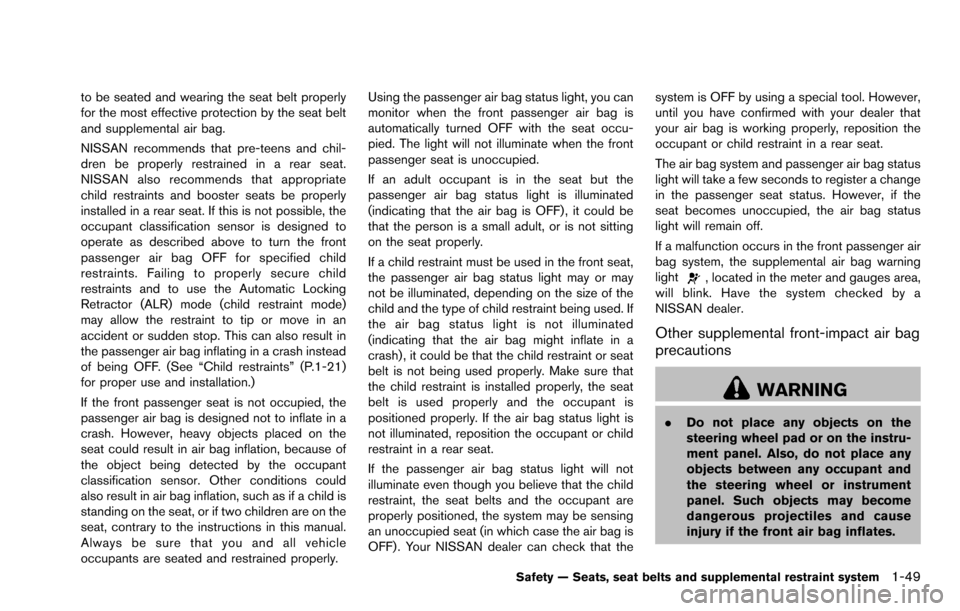
to be seated and wearing the seat belt properly
for the most effective protection by the seat belt
and supplemental air bag.
NISSAN recommends that pre-teens and chil-
dren be properly restrained in a rear seat.
NISSAN also recommends that appropriate
child restraints and booster seats be properly
installed in a rear seat. If this is not possible, the
occupant classification sensor is designed to
operate as described above to turn the front
passenger air bag OFF for specified child
restraints. Failing to properly secure child
restraints and to use the Automatic Locking
Retractor (ALR) mode (child restraint mode)
may allow the restraint to tip or move in an
accident or sudden stop. This can also result in
the passenger air bag inflating in a crash instead
of being OFF. (See “Child restraints” (P.1-21)
for proper use and installation.)
If the front passenger seat is not occupied, the
passenger air bag is designed not to inflate in a
crash. However, heavy objects placed on the
seat could result in air bag inflation, because of
the object being detected by the occupant
classification sensor. Other conditions could
also result in air bag inflation, such as if a child is
standing on the seat, or if two children are on the
seat, contrary to the instructions in this manual.
Always be sure that you and all vehicle
occupants are seated and restrained properly.Using the passenger air bag status light, you can
monitor when the front passenger air bag is
automatically turned OFF with the seat occu-
pied. The light will not illuminate when the front
passenger seat is unoccupied.
If an adult occupant is in the seat but the
passenger air bag status light is illuminated
(indicating that the air bag is OFF) , it could be
that the person is a small adult, or is not sitting
on the seat properly.
If a child restraint must be used in the front seat,
the passenger air bag status light may or may
not be illuminated, depending on the size of the
child and the type of child restraint being used. If
the air bag status light is not illuminated
(indicating that the air bag might inflate in a
crash) , it could be that the child restraint or seat
belt is not being used properly. Make sure that
the child restraint is installed properly, the seat
belt is used properly and the occupant is
positioned properly. If the air bag status light is
not illuminated, reposition the occupant or child
restraint in a rear seat.
If the passenger air bag status light will not
illuminate even though you believe that the child
restraint, the seat belts and the occupant are
properly positioned, the system may be sensing
an unoccupied seat (in which case the air bag is
OFF) . Your NISSAN dealer can check that the
system is OFF by using a special tool. However,
until you have confirmed with your dealer that
your air bag is working properly, reposition the
occupant or child restraint in a rear seat.
The air bag system and passenger air bag status
light will take a few seconds to register a change
in the passenger seat status. However, if the
seat becomes unoccupied, the air bag status
light will remain off.
If a malfunction occurs in the front passenger air
bag system, the supplemental air bag warning
light
, located in the meter and gauges area,
will blink. Have the system checked by a
NISSAN dealer.
Other supplemental front-impact air bag
precautions
WARNING
. Do not place any objects on the
steering wheel pad or on the instru-
ment panel. Also, do not place any
objects between any occupant and
the steering wheel or instrument
panel. Such objects may become
dangerous projectiles and cause
injury if the front air bag inflates.
Safety — Seats, seat belts and supplemental restraint system1-49
Page 112 of 322
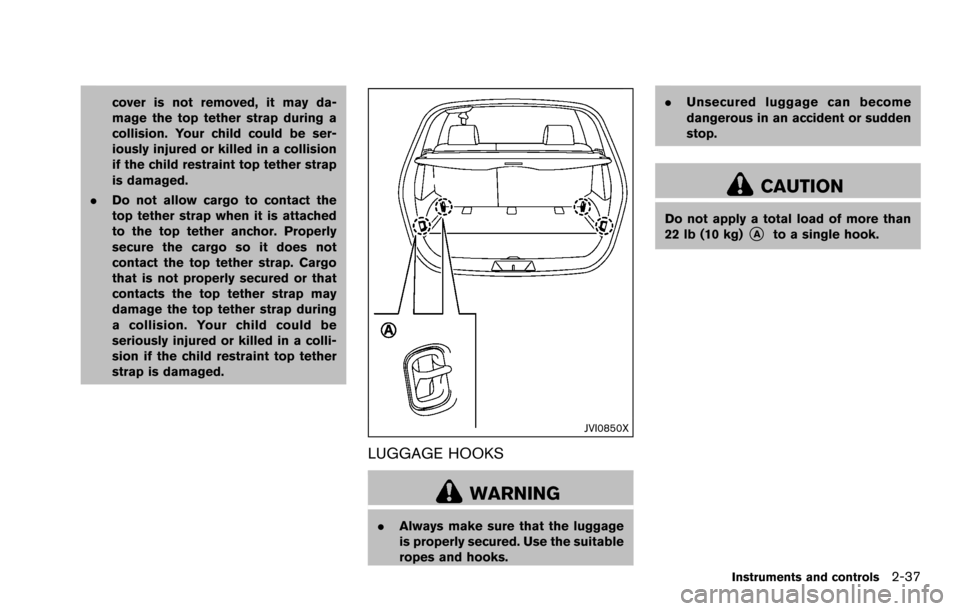
cover is not removed, it may da-
mage the top tether strap during a
collision. Your child could be ser-
iously injured or killed in a collision
if the child restraint top tether strap
is damaged.
. Do not allow cargo to contact the
top tether strap when it is attached
to the top tether anchor. Properly
secure the cargo so it does not
contact the top tether strap. Cargo
that is not properly secured or that
contacts the top tether strap may
damage the top tether strap during
a collision. Your child could be
seriously injured or killed in a colli-
sion if the child restraint top tether
strap is damaged.
JVI0850X
LUGGAGE HOOKS
WARNING
.Always make sure that the luggage
is properly secured. Use the suitable
ropes and hooks. .
Unsecured luggage can become
dangerous in an accident or sudden
stop.
CAUTION
Do not apply a total load of more than
22 lb (10 kg)*Ato a single hook.
Instruments and controls2-37
Page 296 of 322
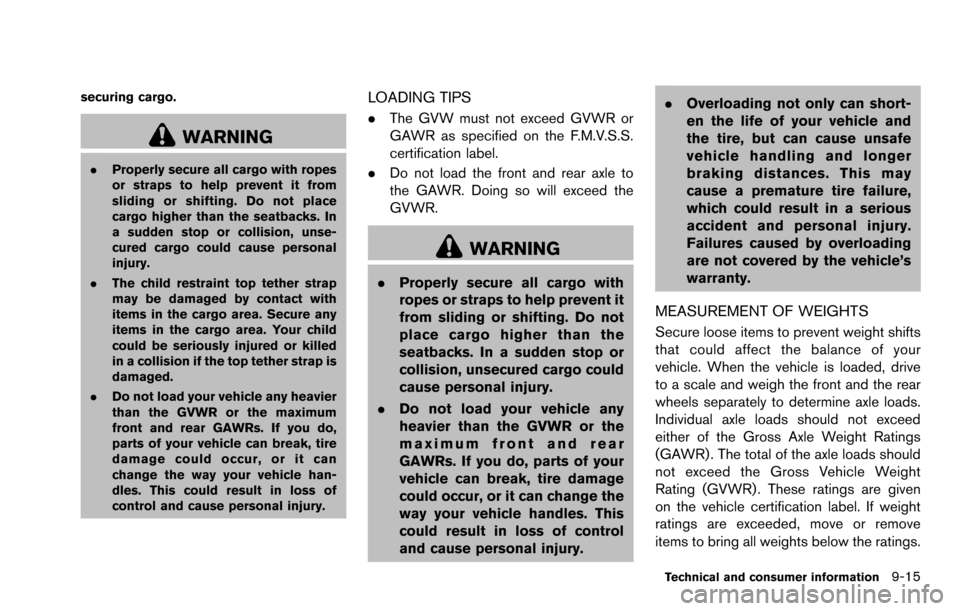
securing cargo.
WARNING
.Properly secure all cargo with ropes
or straps to help prevent it from
sliding or shifting. Do not place
cargo higher than the seatbacks. In
a sudden stop or collision, unse-
cured cargo could cause personal
injury.
. The child restraint top tether strap
may be damaged by contact with
items in the cargo area. Secure any
items in the cargo area. Your child
could be seriously injured or killed
in a collision if the top tether strap is
damaged.
. Do not load your vehicle any heavier
than the GVWR or the maximum
front and rear GAWRs. If you do,
parts of your vehicle can break, tire
damage could occur, or it can
change the way your vehicle han-
dles. This could result in loss of
control and cause personal injury.
LOADING TIPS
.The GVW must not exceed GVWR or
GAWR as specified on the F.M.V.S.S.
certification label.
. Do not load the front and rear axle to
the GAWR. Doing so will exceed the
GVWR.
WARNING
.Properly secure all cargo with
ropes or straps to help prevent it
from sliding or shifting. Do not
place cargo higher than the
seatbacks. In a sudden stop or
collision, unsecured cargo could
cause personal injury.
. Do not load your vehicle any
heavier than the GVWR or the
maximum front and rear
GAWRs. If you do, parts of your
vehicle can break, tire damage
could occur, or it can change the
way your vehicle handles. This
could result in loss of control
and cause personal injury. .
Overloading not only can short-
en the life of your vehicle and
the tire, but can cause unsafe
vehicle handling and longer
braking distances. This may
cause a premature tire failure,
which could result in a serious
accident and personal injury.
Failures caused by overloading
are not covered by the vehicle’s
warranty.
MEASUREMENT OF WEIGHTS
Secure loose items to prevent weight shifts
that could affect the balance of your
vehicle. When the vehicle is loaded, drive
to a scale and weigh the front and the rear
wheels separately to determine axle loads.
Individual axle loads should not exceed
either of the Gross Axle Weight Ratings
(GAWR) . The total of the axle loads should
not exceed the Gross Vehicle Weight
Rating (GVWR) . These ratings are given
on the vehicle certification label. If weight
ratings are exceeded, move or remove
items to bring all weights below the ratings.
Technical and consumer information9-15
Page 312 of 322
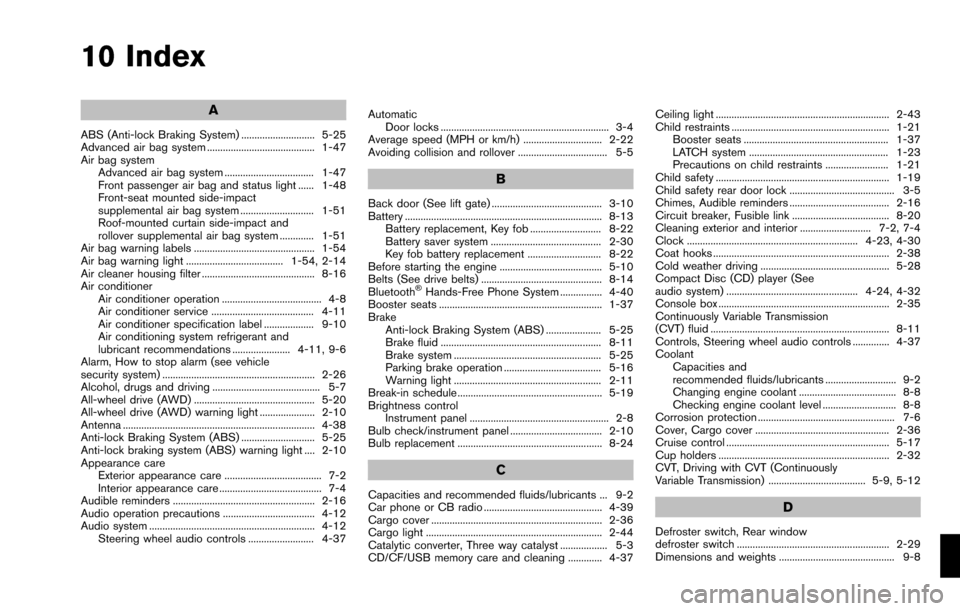
10 Index
A
ABS (Anti-lock Braking System) ............................ 5-25
Advanced air bag system ......................................... 1-47
Air bag systemAdvanced air bag system .................................. 1-47
Front passenger air bag and status light ...... 1-48
Front-seat mounted side-impact
supplemental air bag system ............................ 1-51
Roof-mounted curtain side-impact and
rollover supplemental air bag system ............. 1-51
Air bag warning labels .............................................. 1-54
Air bag warning light ..................................... 1-54, 2-14
Air cleaner housing filter ........................................... 8-16
Air conditioner Air conditioner operation ...................................... 4-8
Air conditioner service ....................................... 4-11
Air conditioner specification label ................... 9-10
Air conditioning system refrigerant and
lubricant recommendations ...................... 4-11, 9-6
Alarm, How to stop alarm (see vehicle
security system) .......................................................... 2-26
Alcohol, drugs and driving ......................................... 5-7
All-wheel drive (AWD) .............................................. 5-20
All-wheel drive (AWD) warning light ..................... 2-10
Antenna ......................................................................... 4-38
Anti-lock Braking System (ABS) ............................ 5-25
Anti-lock braking system (ABS) warning light .... 2-10
Appearance care Exterior appearance care ..................................... 7-2
Interior appearance care ....................................... 7-4
Audible reminders ...................................................... 2-16
Audio operation precautions ................................... 4-12
Audio system ............................................................... 4-12 Steering wheel audio controls ......................... 4-37 Automatic
Door locks ................................................................ 3-4
Average speed (MPH or km/h) .............................. 2-22
Avoiding collision and rollover .................................. 5-5
B
Back door (See lift gate) .......................................... 3-10
Battery ........................................................................... 8-13 Battery replacement, Key fob ........................... 8-22
Battery saver system .......................................... 2-30
Key fob battery replacement ............................ 8-22
Before starting the engine ....................................... 5-10
Belts (See drive belts) .............................................. 8-14
Bluetooth
�ŠHands-Free Phone System ................ 4-40
Booster seats .............................................................. 1-37
Brake Anti-lock Braking System (ABS) ..................... 5-25
Brake fluid ............................................................. 8-11
Brake system ........................................................ 5-25
Parking brake operation ..................................... 5-16
Warning light ........................................................ 2-11
Break-in schedule ....................................................... 5-19
Brightness control Instrument panel ..................................................... 2-8
Bulb check/instrument panel ................................... 2-10
Bulb replacement ....................................................... 8-24
C
Capacities and recommended fluids/lubricants ... 9-2
Car phone or CB radio ............................................. 4-39
Cargo cover ................................................................. 2-36
Cargo light ................................................................... 2-44
Catalytic converter, Three way catalyst .................. 5-3
CD/CF/USB memory care and cleaning ............. 4-37 Ceiling light .................................................................. 2-43
Child restraints ............................................................ 1-21
Booster seats ....................................................... 1-37
LATCH system ..................................................... 1-23
Precautions on child restraints ........................ 1-21
Child safety .................................................................. 1-19
Child safety rear door lock ........................................ 3-5
Chimes, Audible reminders ...................................... 2-16
Circuit breaker, Fusible link ..................................... 8-20
Cleaning exterior and interior ........................... 7-2, 7-4
Clock ................................................................. 4-23, 4-30
Coat hooks ................................................................... 2-38
Cold weather driving ................................................. 5-28
Compact Disc (CD) player (See
audio system) .................................................. 4-24, 4-32
Console box ................................................................. 2-35
Continuously Variable Transmission
(CVT) fluid .................................................................... 8-11
Controls, Steering wheel audio controls .............. 4-37
Coolant Capacities and
recommended fluids/lubricants ........................... 9-2
Changing engine coolant ..................................... 8-8
Checking engine coolant level ............................ 8-8
Corrosion protection .................................................... 7-6
Cover, Cargo cover ................................................... 2-36
Cruise control .............................................................. 5-17
Cup holders ................................................................. 2-32
CVT, Driving with CVT (Continuously
Variable Transmission) ..................................... 5-9, 5-12D
Defroster switch, Rear window
defroster switch .......................................................... 2-29
Dimensions and weights ............................................ 9-8
Page 314 of 322
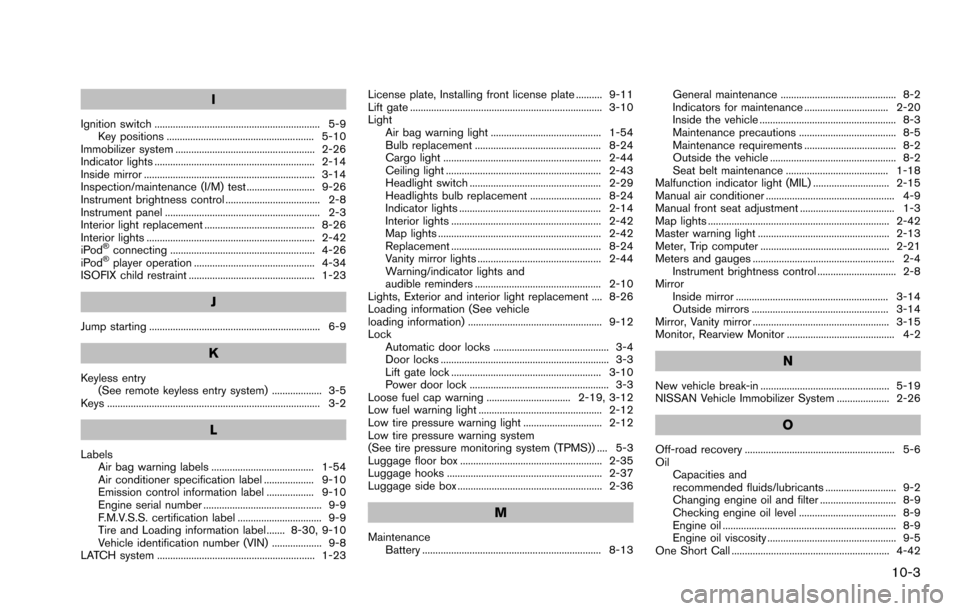
I
Ignition switch ............................................................... 5-9Key positions ........................................................ 5-10
Immobilizer system ..................................................... 2-26
Indicator lights ............................................................. 2-14
Inside mirror ................................................................. 3-14
Inspection/maintenance (I/M) test .......................... 9-26
Instrument brightness control .................................... 2-8
Instrument panel ........................................................... 2-3
Interior light replacement .......................................... 8-26
Interior lights ................................................................ 2-42
iPod
�Šconnecting ....................................................... 4-26
iPod�Šplayer operation .............................................. 4-34
ISOFIX child restraint ................................................ 1-23
J
Jump starting ................................................................. 6-9
K
Keyless entry (See remote keyless entry system) ................... 3-5
Keys ................................................................................. 3-2
L
Labels Air bag warning labels ....................................... 1-54
Air conditioner specification label ................... 9-10
Emission control information label .................. 9-10
Engine serial number ............................................. 9-9
F.M.V.S.S. certification label ................................ 9-9
Tire and Loading information label ....... 8-30, 9-10
Vehicle identification number (VIN) ................... 9-8
LATCH system ............................................................ 1-23 License plate, Installing front license plate .......... 9-11
Lift gate ......................................................................... 3-10
Light
Air bag warning light .......................................... 1-54
Bulb replacement ................................................ 8-24
Cargo light ............................................................ 2-44
Ceiling light ........................................................... 2-43
Headlight switch .................................................. 2-29
Headlights bulb replacement ........................... 8-24
Indicator lights ...................................................... 2-14
Interior lights ......................................................... 2-42
Map lights .............................................................. 2-42
Replacement ......................................................... 8-24
Vanity mirror lights ............................................... 2-44
Warning/indicator lights and
audible reminders ................................................ 2-10
Lights, Exterior and interior light replacement .... 8-26
Loading information (See vehicle
loading information) ................................................... 9-12
Lock
Automatic door locks ............................................ 3-4
Door locks ................................................................ 3-3
Lift gate lock ......................................................... 3-10
Power door lock ..................................................... 3-3
Loose fuel cap warning ................................ 2-19, 3-12
Low fuel warning light ............................................... 2-12
Low tire pressure warning light .............................. 2-12
Low tire pressure warning system
(See tire pressure monitoring system (TPMS)) .... 5-3
Luggage floor box ...................................................... 2-35
Luggage hooks ........................................................... 2-37
Luggage side box ....................................................... 2-36
M
Maintenance Battery .................................................................... 8-13 General maintenance ............................................ 8-2
Indicators for maintenance ................................ 2-20
Inside the vehicle .................................................... 8-3
Maintenance precautions ..................................... 8-5
Maintenance requirements ................................... 8-2
Outside the vehicle ................................................ 8-2
Seat belt maintenance ....................................... 1-18
Malfunction indicator light (MIL) ............................. 2-15
Manual air conditioner ................................................. 4-9
Manual front seat adjustment .................................... 1-3
Map lights ..................................................................... 2-42
Master warning light .................................................. 2-13
Meter, Trip computer ................................................. 2-21
Meters and gauges ...................................................... 2-4 Instrument brightness control .............................. 2-8
Mirror Inside mirror .......................................................... 3-14
Outside mirrors .................................................... 3-14
Mirror, Vanity mirror .................................................... 3-15
Monitor, Rearview Monitor ......................................... 4-2
N
New vehicle break-in ................................................. 5-19
NISSAN Vehicle Immobilizer System .................... 2-26
O
Off-road recovery ......................................................... 5-6
Oil Capacities and
recommended fluids/lubricants ........................... 9-2
Changing engine oil and filter ............................. 8-9
Checking engine oil level ..................................... 8-9
Engine oil .................................................................. 8-9
Engine oil viscosity ................................................. 9-5
One Short Call ............................................................ 4-42
10-3